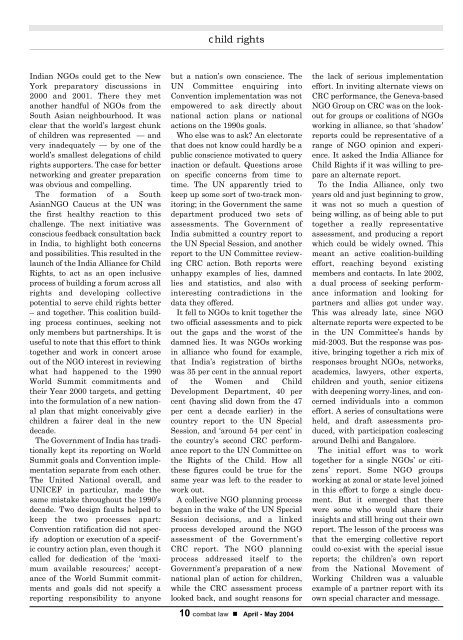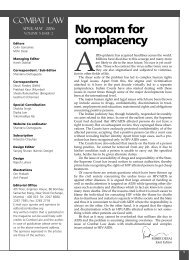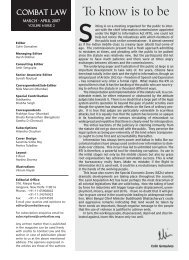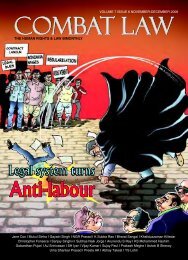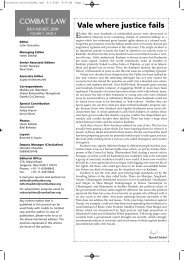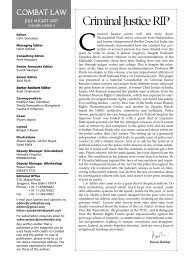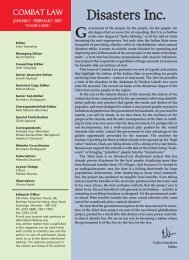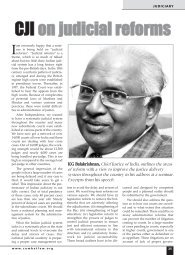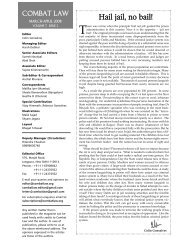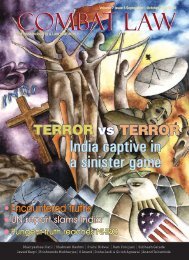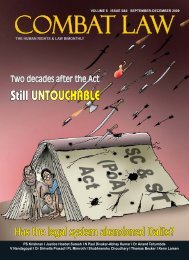PDF, 1.1MB - Combat Law
PDF, 1.1MB - Combat Law
PDF, 1.1MB - Combat Law
Create successful ePaper yourself
Turn your PDF publications into a flip-book with our unique Google optimized e-Paper software.
child rightsIndian NGOs could get to the NewYork preparatory discussions in2000 and 2001. There they metanother handful of NGOs from theSouth Asian neighbourhood. It wasclear that the world’s largest chunkof children was represented — andvery inadequately — by one of theworld’s smallest delegations of childrights supporters. The case for betternetworking and greater preparationwas obvious and compelling.The formation of a SouthAsianNGO Caucus at the UN wasthe first healthy reaction to thischallenge. The next initiative wasconscious feedback consultation backin India, to highlight both concernsand possibilities. This resulted in thelaunch of the India Alliance for ChildRights, to act as an open inclusiveprocess of building a forum across allrights and developing collectivepotential to serve child rights better– and together. This coalition buildingprocess continues, seeking notonly members but partnerships. It isuseful to note that this effort to thinktogether and work in concert aroseout of the NGO interest in reviewingwhat had happened to the 1990World Summit commitments andtheir Year 2000 targets, and gettinginto the formulation of a new nationalplan that might conceivably givechildren a fairer deal in the newdecade.The Government of India has traditionallykept its reporting on WorldSummit goals and Convention implementationseparate from each other.The United National overall, andUNICEF in particular, made thesame mistake throughout the 1990’sdecade. Two design faults helped tokeep the two processes apart:Convention ratification did not specifyadoption or execution of a specificcountry action plan, even though itcalled for dedication of the ‘maximumavailable resources;’ acceptanceof the World Summit commitmentsand goals did not specify areporting responsibility to anyonebut a nation’s own conscience. TheUN Committee enquiring intoConvention implementation was notempowered to ask directly aboutnational action plans or nationalactions on the 1990s goals.Who else was to ask? An electoratethat does not know could hardly be apublic conscience motivated to queryinaction or default. Questions aroseon specific concerns from time totime. The UN apparently tried tokeep up some sort of two-track monitoring;in the Government the samedepartment produced two sets ofassessments. The Government ofIndia submitted a country report tothe UN Special Session, and anotherreport to the UN Committee reviewingCRC action. Both reports wereunhappy examples of lies, damnedlies and statistics, and also withinteresting contradictions in thedata they offered.It fell to NGOs to knit together thetwo official assessments and to pickout the gaps and the worst of thedamned lies. It was NGOs workingin alliance who found for example,that India’s registration of birthswas 35 per cent in the annual reportof the Women and ChildDevelopment Department, 40 percent (having slid down from the 47per cent a decade earlier) in thecountry report to the UN SpecialSession, and ‘around 54 per cent’ inthe country’s second CRC performancereport to the UN Committee onthe Rights of the Child. How allthese figures could be true for thesame year was left to the reader towork out.A collective NGO planning processbegan in the wake of the UN SpecialSession decisions, and a linkedprocess developed around the NGOassessment of the Government’sCRC report. The NGO planningprocess addressed itself to theGovernment’s preparation of a newnational plan of action for children,while the CRC assessment processlooked back, and sought reasons for10 combat law • April - May 2004the lack of serious implementationeffort. In inviting alternate views onCRC performance, the Geneva-basedNGO Group on CRC was on the lookoutfor groups or coalitions of NGOsworking in alliance, so that ‘shadow’reports could be representative of arange of NGO opinion and experience.It asked the India Alliance forChild Rights if it was willing to preparean alternate report.To the India Alliance, only twoyears old and just beginning to grow,it was not so much a question ofbeing willing, as of being able to puttogether a really representativeassessment, and producing a reportwhich could be widely owned. Thismeant an active coalition-buildingeffort, reaching beyond existingmembers and contacts. In late 2002,a dual process of seeking performanceinformation and looking forpartners and allies got under way.This was already late, since NGOalternate reports were expected to bein the UN Committee’s hands bymid-2003. But the response was positive,bringing together a rich mix ofresponses brought NGOs, networks,academics, lawyers, other experts,children and youth, senior citizenswith deepening worry-lines, and concernedindividuals into a commoneffort. A series of consultations wereheld, and draft assessments produced,with participation coalescingaround Delhi and Bangalore.The initial effort was to worktogether for a single NGOs’ or citizens’report. Some NGO groupsworking at zonal or state level joinedin this effort to forge a single document.But it emerged that therewere some who would share theirinsights and still bring out their ownreport. The lesson of the process wasthat the emerging collective reportcould co-exist with the special issuereports; the children’s own reportfrom the National Movement ofWorking Children was a valuableexample of a partner report with itsown special character and message.


